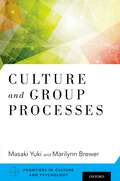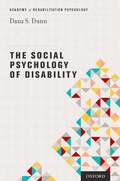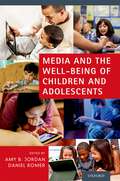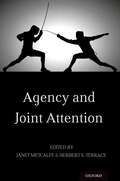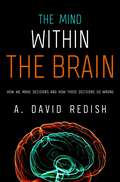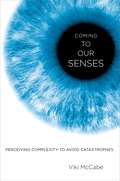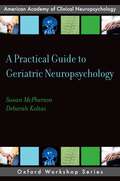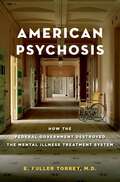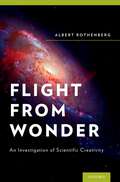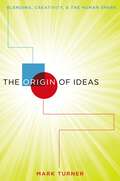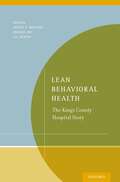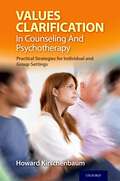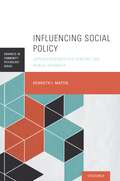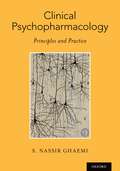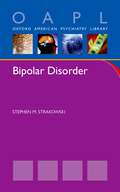- Table View
- List View
Culture and Group Processes (Frontiers in Culture and Pyschology)
by Masaki Yuki and Marilynn B. BrewerHuman beings are adapted for group living. Groups have a wide range of adaptive functions for individuals, including both material benefits of mutual aid and collective action, and subjective psychological benefits of affiliation and social identity. Recent development of cultural psychology, however, has uncovered that culture plays crucial roles in group processes: patterns of group behavior and underlying psychological processes are shaped within specific cultural contexts, and cultures emerge in group-based interactions. Culture and Group Processes, the inaugural volume of the Frontiers of Culture and Psychology series, is the first edited book on this rapidly emerging research topic. The eleven chapters included in this volume, all authored by distinguished scientists in the field, reveal the role of culture in group perceptions, social identity, group dynamics, identity negotiation, teamwork, intergroup relations, and intergroup communication, as well as the joint effect of cultural and group processes in interpersonal trust and creativity.
The Social Psychology of Disability (Academy of Rehabilitation Psychology Series)
by Dana DunnThis is the first book to systematically review, update, organize, and critique the literature on the social psychology of disability in 30 years. The book gives pride of place to classic as well as contemporary concepts from the social psychology of disability and rehabilitation psychology that researchers and clinicians can use or adapt for their professional venues. The book's overarching message is an important one: The experience of most people with disabilities is not what nondisabled persons anticipate--contrary to the latter's beliefs and expectations, the former can lead full and normal lives. Thus, The Social Psychology of Disability is designed to counter stereotypical or biased perspectives aimed at an often overlooked minority group. The primary audience for the book is rehabilitation researchers and clinicians in psychology and allied fields (e.g., social work, nursing). A secondary audience includes policy makers and graduate students in rehabilitation and clinical psychology, as well as interested undergraduates.
The Social Psychology of Disability (Academy of Rehabilitation Psychology Series)
by Dana DunnThis is the first book to systematically review, update, organize, and critique the literature on the social psychology of disability in 30 years. The book gives pride of place to classic as well as contemporary concepts from the social psychology of disability and rehabilitation psychology that researchers and clinicians can use or adapt for their professional venues. The book's overarching message is an important one: The experience of most people with disabilities is not what nondisabled persons anticipate--contrary to the latter's beliefs and expectations, the former can lead full and normal lives. Thus, The Social Psychology of Disability is designed to counter stereotypical or biased perspectives aimed at an often overlooked minority group. The primary audience for the book is rehabilitation researchers and clinicians in psychology and allied fields (e.g., social work, nursing). A secondary audience includes policy makers and graduate students in rehabilitation and clinical psychology, as well as interested undergraduates.
Psychological Assessment of Veterans
by Shane S. BushPsychological assessment is practiced in wide-ranging settings to address the varied clinical and administrative needs of veteran populations. Such assessment blends record review, clinical interviews of the veteran and collateral sources of information, behavioral observations, and psychological testing. This book promotes the care and well-being of veterans by bringing together knowledgeable and experienced psychologists to discuss a range of psychological assessment methods and procedures. It aims to help patients and their families, healthcare providers, and concerned citizens gain an improved understanding of veterans' cognitive functioning, emotional states, personality traits, behavioral patterns, and daily functioning. The book begins with a history of the psychological assessment of veterans and investigates its efficacy in different settings, including outpatient mental health, long-term care, primary care, home-based primary care, and telemental health. Later chapters address assessment of a variety of disorders or presenting problems, including substance use disorders, psychotic disorders, mood disorders and suicidal thoughts and behavior, PTSD and other anxiety disorders, attention-deficit/hyperactivity disorder, dementia, pain and pain-related disorders, and polytrauma. The book concludes with important special considerations, including assessment of symptom and performance validity, assessment of homeless veterans and health-related quality of life, and ethical, legal, and professional issues. Psychological Assessment of Veterans provides an essential reference and guide for clinical psychologists, including those working in the subspecialties, and psychology trainees who work with veterans.
Psychological Assessment of Veterans
by Shane S. BushPsychological assessment is practiced in wide-ranging settings to address the varied clinical and administrative needs of veteran populations. Such assessment blends record review, clinical interviews of the veteran and collateral sources of information, behavioral observations, and psychological testing. This book promotes the care and well-being of veterans by bringing together knowledgeable and experienced psychologists to discuss a range of psychological assessment methods and procedures. It aims to help patients and their families, healthcare providers, and concerned citizens gain an improved understanding of veterans' cognitive functioning, emotional states, personality traits, behavioral patterns, and daily functioning. The book begins with a history of the psychological assessment of veterans and investigates its efficacy in different settings, including outpatient mental health, long-term care, primary care, home-based primary care, and telemental health. Later chapters address assessment of a variety of disorders or presenting problems, including substance use disorders, psychotic disorders, mood disorders and suicidal thoughts and behavior, PTSD and other anxiety disorders, attention-deficit/hyperactivity disorder, dementia, pain and pain-related disorders, and polytrauma. The book concludes with important special considerations, including assessment of symptom and performance validity, assessment of homeless veterans and health-related quality of life, and ethical, legal, and professional issues. Psychological Assessment of Veterans provides an essential reference and guide for clinical psychologists, including those working in the subspecialties, and psychology trainees who work with veterans.
Media and the Well-Being of Children and Adolescents
Media and the Well-Being of Children and Adolescents brings together many of the field's most important scholars and media professionals to present cutting-edge theory and empirical research on both the benefits and risks to youth development. It examines the role that media play in the every-day lives of young people and their families, and considers both traditional media such as television and movies as well as "new" digital media, such as video games, cell phones, and the Internet. The volume is divided into four parts. Part One provides up-to-date trends on children and adolescents' access to media in the home, as well as the time they spend with television, computers, and the Internet. Part Two presents research that highlights the potentially negative impact of age-inappropriate or excess media use on children's physical, cognitive, social, and emotional well-being. Part Three offers examples of how media enhance children's education, health, and social connections. Part Four explores implications for the creation of high-quality, enriching content that speaks to the needs and interests of young people today. The volume's interdisciplinary perspective acknowledges the many controversies surrounding the effects of media on youth, and offers a balanced view of the challenges and opportunities that media represent for healthy development. The book is intended to be a resource for students and scholars working within education, developmental psychology, public health, and communication. Additionally, it speaks to media professionals who seek to create content that enriches the lives of children and adolescents.
Media and the Well-Being of Children and Adolescents
by Daniel RomerMedia and the Well-Being of Children and Adolescents brings together many of the field's most important scholars and media professionals to present cutting-edge theory and empirical research on both the benefits and risks to youth development. It examines the role that media play in the every-day lives of young people and their families, and considers both traditional media such as television and movies as well as "new" digital media, such as video games, cell phones, and the Internet. The volume is divided into four parts. Part One provides up-to-date trends on children and adolescents' access to media in the home, as well as the time they spend with television, computers, and the Internet. Part Two presents research that highlights the potentially negative impact of age-inappropriate or excess media use on children's physical, cognitive, social, and emotional well-being. Part Three offers examples of how media enhance children's education, health, and social connections. Part Four explores implications for the creation of high-quality, enriching content that speaks to the needs and interests of young people today. The volume's interdisciplinary perspective acknowledges the many controversies surrounding the effects of media on youth, and offers a balanced view of the challenges and opportunities that media represent for healthy development. The book is intended to be a resource for students and scholars working within education, developmental psychology, public health, and communication. Additionally, it speaks to media professionals who seek to create content that enriches the lives of children and adolescents.
Agency and Joint Attention
by Janet Metcalfe Herbert S. TerraceHuman infants do not seem to be born with concepts of self or joint attention. One basic goal of Agency and Joint Attention is to unravel how these abilities originate. One approach that has received a lot of recent attention is social. Some argue that by virtue of an infant's intense eye gaze with her mother, she is able, by the age of four months, to establish a relationship with her mother that differentiates between "me" and "you." At about twelve months, the infant acquires the non-verbal ability to share attention with her mother or other caregivers. Although the concepts of self and joint attention are nonverbal and uniquely human, the question remains, how do we establish metacognitive control of these abilities? A tangential question is whether nonhuman animals develop abilities that are analogous to self and joint attention. Much of this volume is devoted to the development of metacognition of self and joint attention in experiments on the origin of consciousness, knowing oneself, social referencing, joint action, the neurological basis of joint attention, the role of joint action, mirror neurons, phenomenology, and cues for agency.
The Mind within the Brain: How We Make Decisions and How those Decisions Go Wrong
by A. David RedishIn The Mind within the Brain, David Redish brings together cutting edge research in psychology, robotics, economics, neuroscience, and the new fields of neuroeconomics and computational psychiatry, to offer a unified theory of human decision-making. Most importantly, Redish shows how vulnerabilities, or "failure-modes," in the decision-making system can lead to serious dysfunctions, such as irrational behavior, addictions, problem gambling, and PTSD. Told with verve and humor in an easily readable style, Redish makes these difficult concepts understandable. Ranging widely from the surprising roles of emotion, habit, and narrative in decision-making, to the larger philosophical questions of how mind and brain are related, what makes us human, the nature of morality, free will, and the conundrum of robotics and consciousness, The Mind within the Brain offers fresh insight into one of the most complex aspects of human behavior.
Coming to Our Senses: Perceiving Complexity to Avoid Catastrophes
by Viki McCabeIn Coming to Our Senses, cognitive scientist Viki McCabe argues that prevailing theories of perception, cognition, and information cannot explain how we know the world around us. Using scientific studies and true stories, McCabe shows that the ecological disasters, political paralysis, and economic failures we now face originate in our tendency to privilege cognitive processes and products over the information we access with our perceptual systems. As a result, we typically default to making decisions using inaccurate information such as mechanistic theories that reduce the world to extractable, exploitable parts. But the world does not function as an assembly of parts; it functions as a coalition of complex systems--from cells to cities--that organize and sustain themselves and cannot be partitioned and retain their purpose. McCabe also argues that we cannot describe such systems using theories and words. Instead, each system reveals itself in fractal-like geometric configurations that emerge from and reflect the structural organization that brings it into existence and determines its functions--a veritable physics of information. Thus, we comprehend phenomena as disparate as neural networks, river deltas, and economies by perceiving the branching geometry that organizes them into distribution systems. McCabe's key point is that form not only follows function, it doubles as information. If we put our theories aside and focus on the information the world displays, our perceptions can block hostile mental takeovers, reconnect us to reality, and bring us back to our senses.
Coming to Our Senses: Perceiving Complexity to Avoid Catastrophes
by Viki McCabeIn Coming to Our Senses, cognitive scientist Viki McCabe argues that prevailing theories of perception, cognition, and information cannot explain how we know the world around us. Using scientific studies and true stories, McCabe shows that the ecological disasters, political paralysis, and economic failures we now face originate in our tendency to privilege cognitive processes and products over the information we access with our perceptual systems. As a result, we typically default to making decisions using inaccurate information such as mechanistic theories that reduce the world to extractable, exploitable parts. But the world does not function as an assembly of parts; it functions as a coalition of complex systems--from cells to cities--that organize and sustain themselves and cannot be partitioned and retain their purpose. McCabe also argues that we cannot describe such systems using theories and words. Instead, each system reveals itself in fractal-like geometric configurations that emerge from and reflect the structural organization that brings it into existence and determines its functions--a veritable physics of information. Thus, we comprehend phenomena as disparate as neural networks, river deltas, and economies by perceiving the branching geometry that organizes them into distribution systems. McCabe's key point is that form not only follows function, it doubles as information. If we put our theories aside and focus on the information the world displays, our perceptions can block hostile mental takeovers, reconnect us to reality, and bring us back to our senses.
A Practical Guide to Geriatric Neuropsychology (AACN Workshop Series)
by Susan McPherson Deborah KoltaiA Practical Guide to Geriatric Neuropsychology focuses on the skills required in testing and treating the older adult population. Topics discussed include normal aging, determining competency, important factors to consider in conducting clinical interviews, the importance of evaluating for depression and substance abuse, screening tools for use in practice, cognitive training and intervention and evaluation of the older adult in the workplace. This book will be helpful for neuropsychologists interested in testing and providing recommendations for older adults and for psychologists interested in treating older adults.
A Practical Guide to Geriatric Neuropsychology (AACN Workshop Series)
by Susan McPherson Deborah KoltaiA Practical Guide to Geriatric Neuropsychology focuses on the skills required in testing and treating the older adult population. Topics discussed include normal aging, determining competency, important factors to consider in conducting clinical interviews, the importance of evaluating for depression and substance abuse, screening tools for use in practice, cognitive training and intervention and evaluation of the older adult in the workplace. This book will be helpful for neuropsychologists interested in testing and providing recommendations for older adults and for psychologists interested in treating older adults.
American Psychosis: How the Federal Government Destroyed the Mental Illness Treatment System
by E. Fuller TorreyIn 1963, President John F. Kennedy delivered an historic speech on mental illness and retardation. He described sweeping new programs to replace "the shabby treatment of the many millions of the mentally disabled in custodial institutions" with treatment in community mental health centers. This movement, later referred to as "deinstitutionalization," continues to impact mental health care. Though he never publicly acknowledged it, the program was a tribute to Kennedy's sister Rosemary, who was born mildly retarded and developed a schizophrenia-like illness. Terrified she'd become pregnant, Joseph Kennedy arranged for his daughter to receive a lobotomy, which was a disaster and left her severely retarded. Fifty years after Kennedy's speech, E. Fuller Torrey's book provides an inside perspective on the birth of the federal mental health program. On staff at the National Institute of Mental Health when the program was being developed and implemented, Torrey draws on his own first-hand account of the creation and launch of the program, extensive research, one-on-one interviews with people involved, and recently unearthed audiotapes of interviews with major figures involved in the legislation. As such, this book provides historical material previously unavailable to the public. Torrey examines the Kennedys' involvement in the policy, the role of major players, the responsibility of the state versus the federal government in caring for the mentally ill, the political maneuverings required to pass the legislation, and how closing institutions resulted not in better care - as was the aim - but in underfunded programs, neglect, and higher rates of community violence. Many now wonder why public mental illness services are so ineffective. At least one-third of the homeless are seriously mentally ill, jails and prisons are grossly overcrowded, largely because the seriously mentally ill constitute 20 percent of prisoners, and public facilities are overrun by untreated individuals. As Torrey argues, it is imperative to understand how we got here in order to move forward towards providing better care for the most vulnerable.
Flight from Wonder: An Investigation of Scientific Creativity
by Albert RothenbergFlight from Wonder reports the findings from an empirical study of 45 Nobel laureates in science from the United States and Europe concerning the creative processes that produce scientific discoveries. To this end, Albert Rothenberg designed an interview procedure to delineate the content and sequences of processes that lead scientists to specific creative achievements. He conducted interviews with Nobel laureates in the fields of medicine, physiology, physics, and chemistry and carried out matching interviews with a control group consisting of twelve accomplished engineers on the faculty of a leading engineering university. Rothenberg's results demonstrate that the Nobel laureates use three distinct cognitive creative processes to achieve key formulations and discoveries; the detailed nature and structure of these findings were reviewed by the Nobel laureates. To predict his findings, Rothenberg engaged with autobiographical accounts and work-in-progress manuscripts pertaining to the creative discoveries of outstanding scientists of the past including Albert Einstein, Charles Darwin, Max Planck, Neils Bohr, Hideki Yukawa, and James Watson. The book will interest students and general readers fascinated by creativity and the development of scientific inquiry and innovation.
Flight from Wonder: An Investigation of Scientific Creativity
by Albert RothenbergFlight from Wonder reports the findings from an empirical study of 45 Nobel laureates in science from the United States and Europe concerning the creative processes that produce scientific discoveries. To this end, Albert Rothenberg designed an interview procedure to delineate the content and sequences of processes that lead scientists to specific creative achievements. He conducted interviews with Nobel laureates in the fields of medicine, physiology, physics, and chemistry and carried out matching interviews with a control group consisting of twelve accomplished engineers on the faculty of a leading engineering university. Rothenberg's results demonstrate that the Nobel laureates use three distinct cognitive creative processes to achieve key formulations and discoveries; the detailed nature and structure of these findings were reviewed by the Nobel laureates. To predict his findings, Rothenberg engaged with autobiographical accounts and work-in-progress manuscripts pertaining to the creative discoveries of outstanding scientists of the past including Albert Einstein, Charles Darwin, Max Planck, Neils Bohr, Hideki Yukawa, and James Watson. The book will interest students and general readers fascinated by creativity and the development of scientific inquiry and innovation.
The Origin of Ideas: Blending, Creativity, and the Human Spark
by Mark TurnerWhat makes human beings so innovative, so adept at rapid, creative thinking? Where do new ideas come from, and once we have them, how can we carry them mentally into new situations? What allows our thinking to range easily over time, space, causation, and agency-so easily that we take this truly remarkable ability for granted? In The Origin of Ideas, Mark Turner offers a provocative new theory to answer these and many other questions. While other species do what we cannot-fly, run amazingly fast, see in the dark-only human beings can innovate so rapidly and widely. Turner argues that this distinctively human spark was an evolutionary advance that developed from a particular kind of mental operation, which he calls "blending": our ability to take two or more ideas and create a new idea in the "blend." Turner begins by looking at the "lionman," a 32,000-year-old ivory figurine, one of the earliest examples of blending. Here, the concepts "lion" and "man" are merged into a new figure, the "lionman." Turner argues that at some stage during the Paleolithic Age, humans reached a tipping point. Before that, we were a bunch of large, unimaginative mammals. After that, we were poised to take over the world. Once biological evolution hit upon making brains that could do advanced blending, we possessed the capacity to invent and maintain culture. Cultural innovation could then progress by leaps and bounds over biological evolution itself, leading to the highest forms of human cognition and creativity. For anyone interested in how and why our minds work the way they do, The Origin of Ideas offers a wealth of original insights-and is itself a brilliant example of the innovative thinking it describes.
The Origin of Ideas: Blending, Creativity, and the Human Spark
by Mark TurnerWhat makes human beings so innovative, so adept at rapid, creative thinking? Where do new ideas come from, and once we have them, how can we carry them mentally into new situations? What allows our thinking to range easily over time, space, causation, and agency-so easily that we take this truly remarkable ability for granted? In The Origin of Ideas, Mark Turner offers a provocative new theory to answer these and many other questions. While other species do what we cannot-fly, run amazingly fast, see in the dark-only human beings can innovate so rapidly and widely. Turner argues that this distinctively human spark was an evolutionary advance that developed from a particular kind of mental operation, which he calls "blending": our ability to take two or more ideas and create a new idea in the "blend." Turner begins by looking at the "lionman," a 32,000-year-old ivory figurine, one of the earliest examples of blending. Here, the concepts "lion" and "man" are merged into a new figure, the "lionman." Turner argues that at some stage during the Paleolithic Age, humans reached a tipping point. Before that, we were a bunch of large, unimaginative mammals. After that, we were poised to take over the world. Once biological evolution hit upon making brains that could do advanced blending, we possessed the capacity to invent and maintain culture. Cultural innovation could then progress by leaps and bounds over biological evolution itself, leading to the highest forms of human cognition and creativity. For anyone interested in how and why our minds work the way they do, The Origin of Ideas offers a wealth of original insights-and is itself a brilliant example of the innovative thinking it describes.
Lean Behavioral Health: The Kings County Hospital Story
by Joseph P. Merlino Joanna Omi Jill BowenLean Behavioral Health: The Kings County Hospital Story is the first lean book that focuses entirely on behavioral health. Using the principles of the Toyota Production System, or lean, the contributors in this groundbreaking volume share their experience in transforming a major safety net public hospital after a tragic and internationally publicized event. As the largest municipal hospital system in the United States, the New York City Health & Hospitals Corporation adopted lean as the transformational approach for all of its hospitals and clinics. Kings County Hospital Center, one of the largest providers of behavioral health care in the country, continues on its transformational journey utilizing lean's techniques. While not every event was fully successful, most were and every event, including failures, increased the knowledge base about how to continually improve quality and safety. Having made major changes, Kings County Hospital Center is now recognized as a center for transformation and quality receiving high marks from oversight agencies. This volume begins by describing the basic principles of the lean approach-adding value, eliminating waste, and tapping the organization's line staff to create and sustain dramatic change. An overview of the use of lean from a quality improvement perspective follows. Lean tools are applied to many services that comprise the behavioral health value stream and these stories are highlighted. The experts in identifying waste and adding value are the line staff whose voices are captured in the clinical chapters. Insights learned by event participants are emphasized as teaching points to provide context for what has worked or has not worked at Kings County Hospital Center. While the burning platform at Kings County Hospital Center was white hot and while the Department of Justice scrutinized its quality of patient care, the application of lean methods and tools has transformed the hospital into a potential model for behavioral health programs facing the challenges of the present healthcare environment. It is a must-have story for clinicians, administrators and other leaders in the mental health field devoted to improving quality and safety at their hospitals and clinics.
Values Clarification in Counseling and Psychotherapy: Practical Strategies for Individual and Group Settings
by Howard KirschenbaumThis work meets a long-standing need in the helping professions by being the first and only comprehensive book on how counselors and psychotherapists can work with clients around values, goal-setting, decision-making and action planning. Helping clients determine their priorities, set goals, make decisions, and take action to improve their lives are common tasks for virtually all helping professionals when engaging with clients. This is the process known as "values clarification" (or "Values Clarification"). While counselors and psychotherapists widely practice values clarification-some knowingly, others unaware-they typically do so with a limited understanding of its theory, methods and various applications. This book demonstrates, with great precision, case studies, and hundreds of clinical examples, how counselors and psychotherapists in many fields can ask good clarifying questions, conduct clarifying interviews, and employ dozens of values clarification strategies with individuals, couples, families, and groups. To illustrate how values clarification can be used to explore a myriad of counseling topics, the examples throughout the text are often grouped around more specific applications for marriage and family counseling, career counseling, substance abuse and recovery counseling, geriatric counseling, grief counseling, pastoral counseling, financial counseling, school counseling, rehabilitation counseling, counselor/clinical education and supervision, health counseling, and personal growth. There are clear descriptions of what values clarification is and is not, theory and research, multicultural and diversity issues, and how counselors and therapists can handle value and moral conflicts with clients. Values clarification is compared and contrasted to other approaches to counseling and psychotherapy, including person-centered, cognitive-behavioral, reality therapy-choice theory, existential, individual psychology, solution-focused, narrative, motivational interviewing, acceptance and commitment therapy, appreciative inquiry, life coaching, and positive psychology.
Values Clarification in Counseling and Psychotherapy: Practical Strategies for Individual and Group Settings
by Howard KirschenbaumThis work meets a long-standing need in the helping professions by being the first and only comprehensive book on how counselors and psychotherapists can work with clients around values, goal-setting, decision-making and action planning. Helping clients determine their priorities, set goals, make decisions, and take action to improve their lives are common tasks for virtually all helping professionals when engaging with clients. This is the process known as "values clarification" (or "Values Clarification"). While counselors and psychotherapists widely practice values clarification-some knowingly, others unaware-they typically do so with a limited understanding of its theory, methods and various applications. This book demonstrates, with great precision, case studies, and hundreds of clinical examples, how counselors and psychotherapists in many fields can ask good clarifying questions, conduct clarifying interviews, and employ dozens of values clarification strategies with individuals, couples, families, and groups. To illustrate how values clarification can be used to explore a myriad of counseling topics, the examples throughout the text are often grouped around more specific applications for marriage and family counseling, career counseling, substance abuse and recovery counseling, geriatric counseling, grief counseling, pastoral counseling, financial counseling, school counseling, rehabilitation counseling, counselor/clinical education and supervision, health counseling, and personal growth. There are clear descriptions of what values clarification is and is not, theory and research, multicultural and diversity issues, and how counselors and therapists can handle value and moral conflicts with clients. Values clarification is compared and contrasted to other approaches to counseling and psychotherapy, including person-centered, cognitive-behavioral, reality therapy-choice theory, existential, individual psychology, solution-focused, narrative, motivational interviewing, acceptance and commitment therapy, appreciative inquiry, life coaching, and positive psychology.
Influencing Social Policy: Applied Psychology Serving the Public Interest (Advances in Community Psychology)
by Kenneth I. MatonInfluencing Social Policy synthesizes current knowledge about how psychologists influence social policy to serve the public interest. The volume builds upon interviews with 79 applied psychologists about their experiences in the policy domain, with special focus on the work of applied developmental psychologists, applied social psychologists, and community psychologists. Additional foundations of the volume include a review of social science scholarship across a wide range of disciplines, and author Kenneth Maton's 30 years of teaching on the topic, including frequent interactions with Washington, DC, policy experts. Together, these sources provide in-depth information about how applied psychologists influence social policy, the factors that contribute to their success, the challenges they face, and the approaches used to address those challenges. The policy influences described span all three branches of government: legislative, executive, and judicial. The policy content areas are diverse, including the death penalty prohibition for adolescents, early childhood education, gay marriage, gender discrimination in the workplace, health and mental health care reform, homelessness, home visiting programs, sexually abused child witness treatment, status offender diversion from the juvenile justice system, substance abuse prevention, and many others. Influencing Social Policy is a must-have resource for graduate students and professionals in a wide variety of disciplines with interests in influencing social policy, including psychology, education, public health, social work, policy studies, anthropology, and sociology.
Clinical Psychopharmacology: Principles and Practice
by S. Nassir GhaemiClinical Psychopharmacology offers a comprehensive guide to clinical practice that explores two major aspects of the field: the clinical research that exists to guide clinical practice of psychopharmacology, and the application of that knowledge with attention to the individualized aspects of clinical practice. The text consists of 50 chapters, organized into 6 sections, focusing on disease-modifying effects, non-DSM diagnostic concepts, and essential facts about the most common drugs. This innovative book advocates a scientific and humanistic approach to practice and examines not only the benefits, but also the harms of drugs. Providing a solid foundation of knowledge and a great deal of practical information, this book is a valuable resource for practicing psychiatrists, psychiatric nurse practitioners, medical students and trainees in psychiatry, as well as pharmacists.
Clinical Psychopharmacology: Principles and Practice
by S. Nassir GhaemiClinical Psychopharmacology offers a comprehensive guide to clinical practice that explores two major aspects of the field: the clinical research that exists to guide clinical practice of psychopharmacology, and the application of that knowledge with attention to the individualized aspects of clinical practice. The text consists of 50 chapters, organized into 6 sections, focusing on disease-modifying effects, non-DSM diagnostic concepts, and essential facts about the most common drugs. This innovative book advocates a scientific and humanistic approach to practice and examines not only the benefits, but also the harms of drugs. Providing a solid foundation of knowledge and a great deal of practical information, this book is a valuable resource for practicing psychiatrists, psychiatric nurse practitioners, medical students and trainees in psychiatry, as well as pharmacists.
Bipolar Disorder (Oxford American Psychiatry Library)
by Stephen StrakowskiBipolar disorder is one of the most common and disabling conditions affecting humankind. It is a leading cause of disability and mortality worldwide, affecting millions of people. The illness is complex and dynamic, so that many individuals are misdiagnosed for years and clinicians struggle with identifying the most appropriate and successful treatment. Because it is complex and common, people suffering from bipolar disorder seek help from clinicians of all types - from psychiatrists, family doctors, gynecologists, and internists to psychologists, social workers and other therapists. For clinicians without significant experience with bipolar disorder, how to manage the condition can be mystifying. Even experienced psychiatrists will frequently find themselves uncertain of the best approach to a given individual with bipolar illness. This pocket-sized guide was specifically written with this diverse group of clinicians in mind. It provides a concise, practical and current overview of bipolar disorder, including making a correct diagnosis, identifying important medical and psychiatric comorbidities, and describing our current understanding of the epidemiology, genetics and neurobiology of the condition. In addition to these topics to provide context, the majority of the book is focused on a programmatic approach toward managing bipolar disorder, including discussions of specific subpopulations, such as children or women who are pregnant. The book may also be of interest for people with bipolar disorder and their families, to help guide treatment seeking and provide education about this sometimes mystifying condition. The author is an internationally recognized and trusted expert in the study and treatment of bipolar disorder, annually named a Best Doctor® and recognized by US News and World Report® as a Top 1% Psychiatrist, whose own extensive clinical experience working with people with bipolar disorder guides this book.
